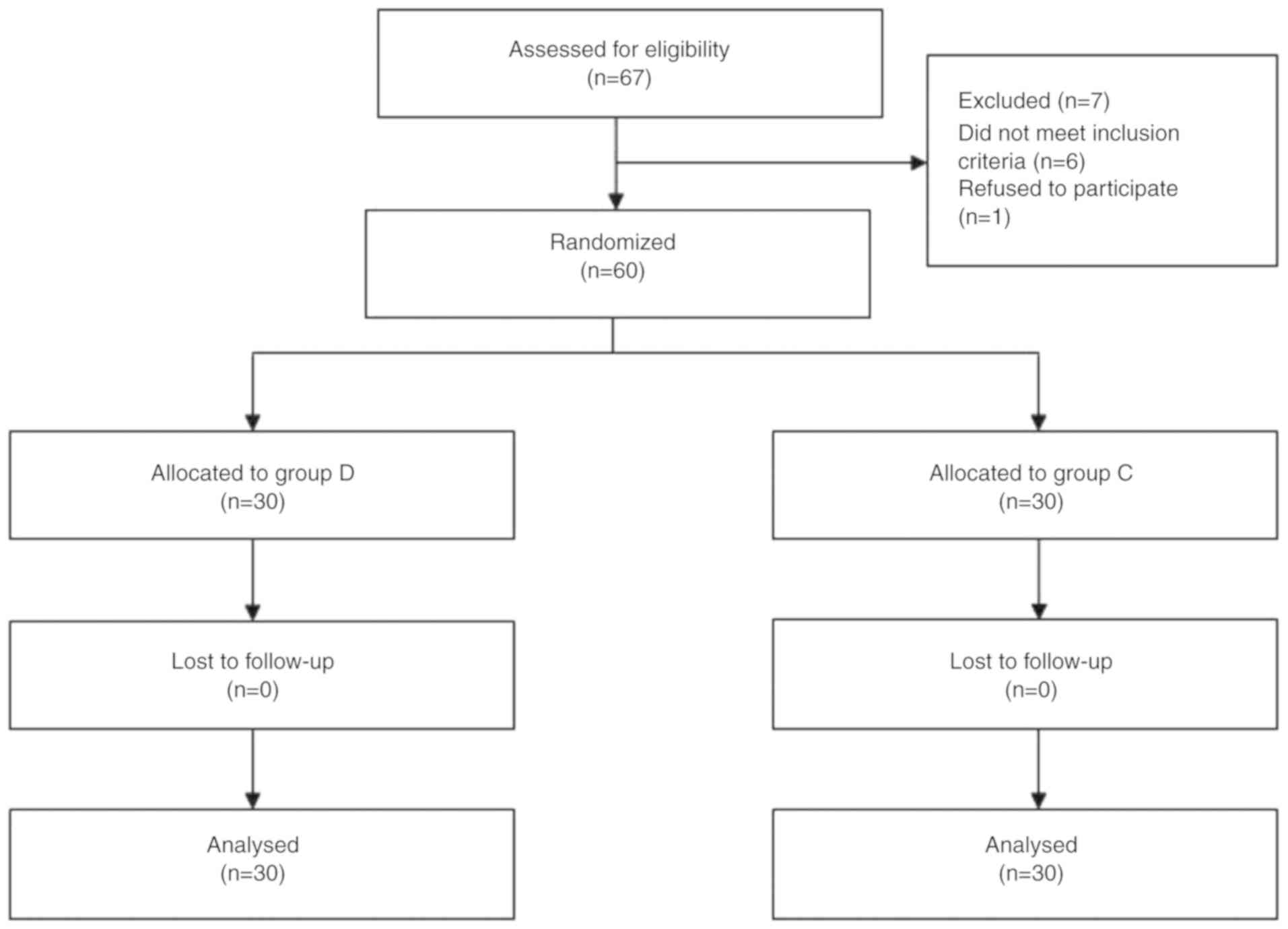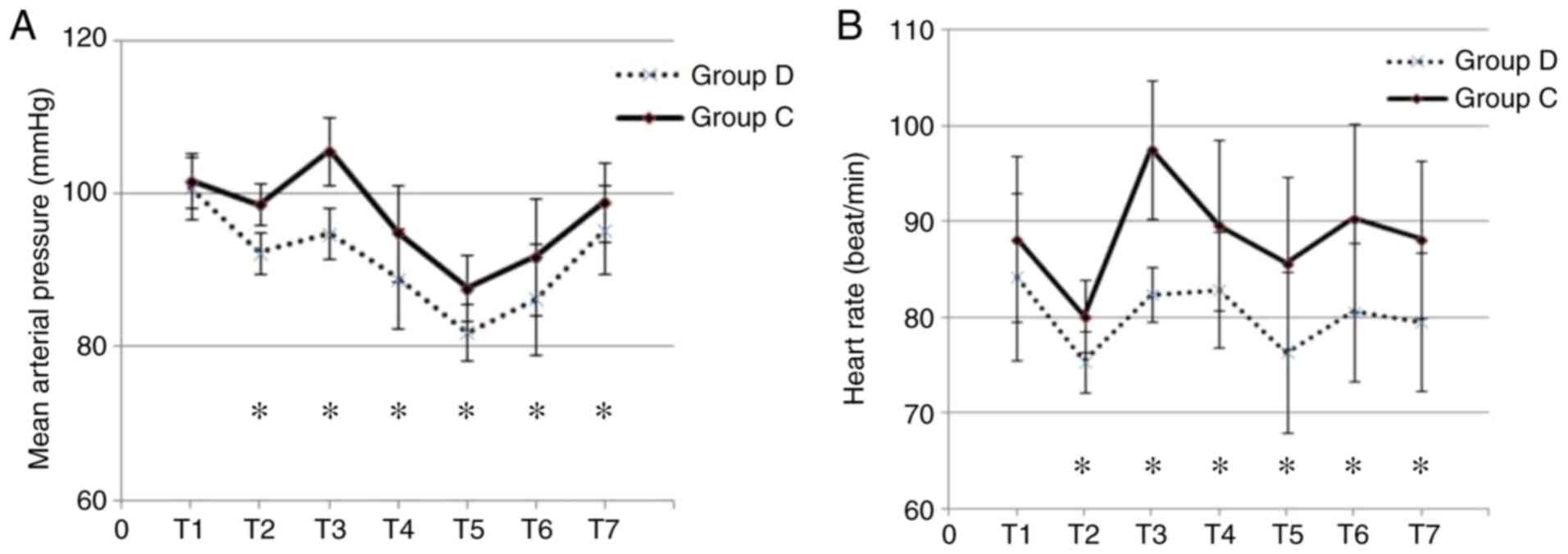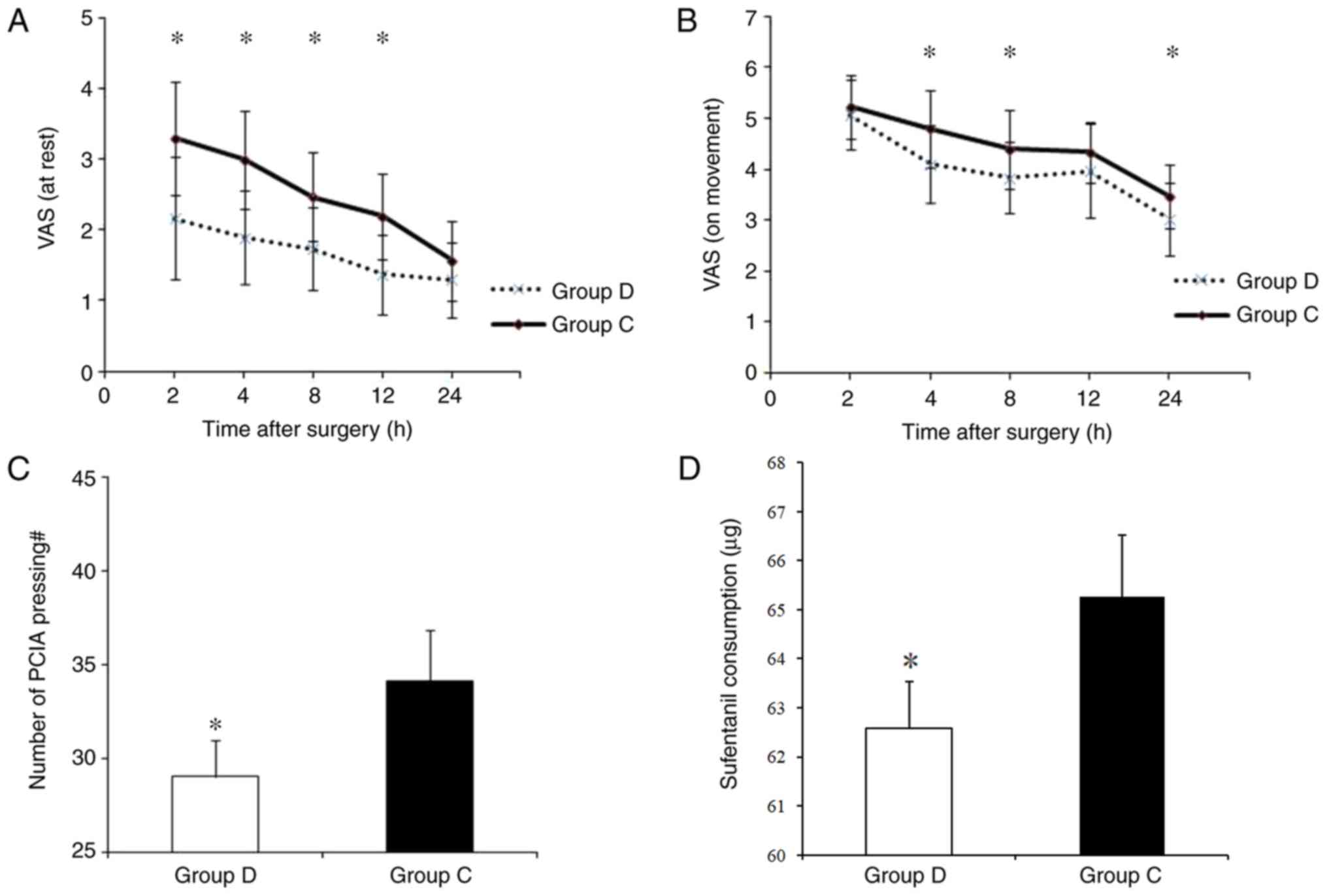|
1
|
de Castro RJ, Leal PC and Sakata RK: Pain
management in burn patients. Braz J Anesthesiol. 63:149–153. 2013.
View Article : Google Scholar : PubMed/NCBI
|
|
2
|
Asmussen S, Maybauer DM, Fraser JF,
Jennings K, George S and Maybauer MO: A meta-analysis of analgesic
and sedative effects of dexmedetomidine in burn patients. Burns.
39:625–631. 2013. View Article : Google Scholar : PubMed/NCBI
|
|
3
|
Gerlach AT and Dasta JF: Dexmedetomidine:
An updated review. Ann Pharmacother. 41:245–252. 2007. View Article : Google Scholar : PubMed/NCBI
|
|
4
|
Ge DJ, Qi B, Tang G and Li JY:
Intraoperative dexmedetomidine promotes postoperative analgesia and
recovery in patients after abdominal hysterectomy: A double-blind,
randomized clinical trial. Sci Rep. 6:215142016. View Article : Google Scholar : PubMed/NCBI
|
|
5
|
Ge DJ, Qi B, Tang G and Li JY:
Intraoperative dexmedetomidine promotes postoperative analgesia and
recovery in patients after abdominal colectomy: A
CONSORT-prospective, randomized, controlled clinical trial.
Medicine (Baltimore). 94:e17272015. View Article : Google Scholar : PubMed/NCBI
|
|
6
|
Gandhi KA, Panda NB, Vellaichamy A, Mathew
PJ, Sahni N and Batra YK: Intraoperative and postoperative
administration of dexmedetomidine reduces anesthetic and
postoperative analgesic requirements in patients undergoing
cervical spine surgeries. J Neurosurg Anesthesiol. 29:258–263.
2017. View Article : Google Scholar : PubMed/NCBI
|
|
7
|
Xin J, Zhang Y, Zhou L, Liu F, Zhou X, Liu
B and Li Q: Effect of dexmedetomidine infusion for intravenous
patient-controlled analgesia on the quality of recovery after
laparotomy surgery. Oncotarget. 8:100371–100383. 2017. View Article : Google Scholar : PubMed/NCBI
|
|
8
|
Cheung CW, Qiu Q, Ying AC, Choi SW, Law WL
and Irwin MG: The effects of intra-operative dexmedetomidine on
postoperative pain, side-effects and recovery in colorectal
surgery. Anaesthesia. 69:1214–1221. 2014. View Article : Google Scholar : PubMed/NCBI
|
|
9
|
Bekker A, Haile M, Kline R, Didehvar S,
Babu R, Martiniuk F and Urban M: The effect of intraoperative
infusion of dexmedetomidine on the quality of recovery after major
spinal surgery. J Neurosurg Anesthesiol. 25:16–24. 2013. View Article : Google Scholar : PubMed/NCBI
|
|
10
|
Kim SH, Oh YJ, Park BW, Sim J and Choi YS:
Effects of single-dose dexmedetomidine on the quality of recovery
after modified radical mastectomy: A randomised controlled trial.
Minerva Anestesiol. 79:1248–1258. 2013.PubMed/NCBI
|
|
11
|
Gündüz M, Sakalli S, Güneş Y, Kesiktaş E,
Ozcengiz D and Işik G: Comparison of effects of ketamine,
ketamine-dexmedetomidine and ketamine-midazolam on dressing changes
of burn patients. J Anaesthesiol Clin Pharmacol. 27:220–224. 2011.
View Article : Google Scholar : PubMed/NCBI
|
|
12
|
Lin H, Faraklas I, Sampson C, Saffle JR
and Cochran A: Use of dexmedetomidine for sedation in critically
ill mechanically ventilated pediatric burn patients. J Burn Care
Res. 32:98–103. 2011. View Article : Google Scholar : PubMed/NCBI
|
|
13
|
Hackett NJ, De Oliveira GS, Jain UK and
Kim JY: ASA class is a reliable independent predictor of medical
complications and mortality following surgery. Int J Surg.
18:184–190. 2015. View Article : Google Scholar : PubMed/NCBI
|
|
14
|
Wu J, Chen Y and Luo Y: Evaluation of the
visual analog score (VAS) to assess acute mountain sickness (AMS)
in a hypobaric chamber. PLoS One. 9:e1133762014. View Article : Google Scholar : PubMed/NCBI
|
|
15
|
Kim SY, Kim JM, Lee JH, Song BM and Koo
BN: Efficacy of intraoperative dexmedetomidine infusion on
emergence agitation and quality of recovery after nasal surgery. Br
J Anaesth. 111:222–228. 2013. View Article : Google Scholar : PubMed/NCBI
|
|
16
|
Bi SS, Deng CH, Zhou TY, Guan Z, Li L, Li
HQ, Zhang LP, Yang L and Lu W: Remifentanil-sevoflurane interaction
models of circulatory response to laryngoscopy and circulatory
depression. Br J Anaesth. 110:729–740. 2013. View Article : Google Scholar : PubMed/NCBI
|
|
17
|
Heyse B, Proost JH, Schumacher PM,
Bouillon TW, Vereecke HE, Eleveld DJ, Luginbühl M and Struys MM:
Sevoflurane remifentanil interaction: Comparison of different
response surface models. Anesthesiology. 116:311–323. 2012.
View Article : Google Scholar : PubMed/NCBI
|
|
18
|
Gornall BF, Myles PS, Smith CL, Burke JA,
Leslie K, Pereira MJ, Bost JE, Kluivers KB, Nilsson UG, Tanaka Y
and Forbes A: Measurement of quality of recovery using the QoR-40:
A quantitative systematic review. Br J Anaesth. 111:161–169. 2013.
View Article : Google Scholar : PubMed/NCBI
|
|
19
|
Myles PS, Weitkamp B, Jones K, Melick J
and Hensen S: Validity and reliability of a postoperative quality
of recovery score: The QoR-40. Br J Anaesth. 84:11–15. 2000.
View Article : Google Scholar : PubMed/NCBI
|
|
20
|
Charan J and Biswas T: How to calculate
sample size for different study designs in medical research? Indian
J Psychol Med. 35:121–126. 2013. View Article : Google Scholar : PubMed/NCBI
|
|
21
|
Gamst-Jensen H, Vedel PN, Lindberg-Larsen
VO and Egerod I: Acute pain management in burn patients: Appraisal
and thematic analysis of four clinical guidelines. Burns.
40:1463–1469. 2014. View Article : Google Scholar : PubMed/NCBI
|
|
22
|
Xu J, Sang N, Ren L and Huang Y: Effect of
different sufentanil concentration regimens on postoperative pain
control and its adverse events in intravenous patient-controlled
analgesia. Zhongguo Yi Xue Ke Xue Yuan Xue Bao. 39:406–410.
2017.PubMed/NCBI
|
|
23
|
Bhana N, Goa KL and McClellan KJ:
Dexmedetomidine. Drugs. 59:263–270. 2000. View Article : Google Scholar : PubMed/NCBI
|
|
24
|
Qin M, Chen K, Liu T and Shen X:
Dexmedetomidine in combination with sufentanil for postoperative
analgesia after partial laryngectomy. BMC Anesthesiol. 17:662017.
View Article : Google Scholar : PubMed/NCBI
|
|
25
|
Nie Y, Liu Y, Luo Q and Huang S: Effect of
dexmedetomidine combined with sufentanil for post-caesarean section
intravenous analgesia: A randomised, placebo-controlled study. Eur
J Anaesthesiol. 31:197–203. 2014. View Article : Google Scholar : PubMed/NCBI
|
|
26
|
Dong CS, Zhang J, Lu Q, Sun P, Yu JM, Wu C
and Sun H: Effect of dexmedetomidine combined with sufentanil for
post-thoracotomy intravenous analgesia: A randomized, controlled
clinical study. BMC Anesthesiol. 17:332017. View Article : Google Scholar : PubMed/NCBI
|
|
27
|
Bloor BC, Ward DS, Belleville JP and Maze
M: Effects of intravenous dexmedetomidine in humans. II.
Hemodynamic changes. Anesthesiology. 77:1134–1142. 1992. View Article : Google Scholar : PubMed/NCBI
|
|
28
|
Samantaray A, Hanumantha Rao M and Sahu
CR: Additional analgesia for central venous catheter insertion: A
placebo controlled randomized trial of dexmedetomidine and
fentanyl. Crit Care Res Pract. 2016:90626582016.PubMed/NCBI
|
|
29
|
Reddy SV, Balaji D and Ahmed SN:
Dexmedetomidine versus esmolol to attenuate the hemodynamic
response to laryngoscopy and tracheal intubation: A randomized
double-blind clinical study. Int J Appl Basic Med Res. 4:95–100.
2014. View Article : Google Scholar : PubMed/NCBI
|
|
30
|
Gogus N, Akan B, Serger N and Baydar M:
The comparison of the effects of dexmedetomidine, fentanyl and
esmolol on prevention of hemodynamic response to intubation. Rev
Bras Anestesiol. 64:314–319. 2014.(In Portuguese). View Article : Google Scholar : PubMed/NCBI
|
|
31
|
Kumari K, Gombar S, Kapoor D and Sandhu
HS: Clinical study to evaluate the role of preoperative
dexmedetomidine in attenuation of hemodynamic response to direct
laryngoscopy and tracheal intubation. Acta Anaesthesiol Taiwan.
53:123–130. 2015. View Article : Google Scholar : PubMed/NCBI
|
|
32
|
Sulaiman S, Karthekeyan RB, Vakamudi M,
Sundar AS, Ravullapalli H and Gandham R: The effects of
dexmedetomidine on attenuation of stress response to endotracheal
intubation in patients undergoing elective off-pump coronary artery
bypass grafting. Ann Card Anaesth. 15:39–43. 2012. View Article : Google Scholar : PubMed/NCBI
|
|
33
|
Basar H, Akpinar S, Doganci N, Buyukkocak
U, Kaymak C, Sert O and Apan A: The effects of preanesthetic,
single-dose dexmedetomidine on induction, hemodynamic, and
cardiovascular parameters. J Clin Anesth. 20:431–436. 2008.
View Article : Google Scholar : PubMed/NCBI
|
|
34
|
Guimarães-Pereira L, Costa M, Sousa G and
Abelha F: Quality of recovery after anaesthesia measured with
QoR-40: A prospective observational study. Braz J Anesthesiol.
66:369–375. 2016.PubMed/NCBI
|
|
35
|
Lee SH, Lee CY, Lee JG, Kim N, Lee HM and
Oh YJ: Intraoperative dexmedetomidine improves the quality of
recovery and postoperative pulmonary function in patients
undergoing video-assisted thoracoscopic surgery: A
CONSORT-prospective, randomized, controlled trial. Medicine
(Baltimore). 95:e28542016. View Article : Google Scholar : PubMed/NCBI
|
|
36
|
Aouad MT, Zeeni C, Al Nawwar R,
Siddik-Sayyid SM, Barakat HB, Elias S and Yazbeck Karam VG:
Dexmedetomidine for improved quality of emergence from general
anesthesia: A dose-finding study = Anesth Analg. 29–Dec;2017.[Epub
ahead of print]. View Article : Google Scholar
|
|
37
|
Duncan JA, Bond JS, Mason T, Ludlow A,
Cridland P, O'Kane S and Ferguson MW: Visual analogue scale scoring
and ranking: A suitable and sensitive method for assessing scar
quality? Plast Reconstr Surg. 118:909–918. 2006. View Article : Google Scholar : PubMed/NCBI
|

















